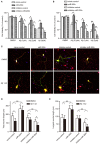The Protective Role of microRNA-200c in Alzheimer's Disease Pathologies Is Induced by Beta Amyloid-Triggered Endoplasmic Reticulum Stress
- PMID: 28008308
- PMCID: PMC5143617
- DOI: 10.3389/fnmol.2016.00140
The Protective Role of microRNA-200c in Alzheimer's Disease Pathologies Is Induced by Beta Amyloid-Triggered Endoplasmic Reticulum Stress
Abstract
MicroRNAs are small non-coding RNAs that repress the expression of their target proteins. The roles of microRNAs in the development of Alzheimer's disease (AD) are not clear. In this study we show that miR-200c represses the expression of PTEN protein. PTEN downregulation by miR-200c supports the survival and differentiation of cultured neurons. AD is a progressive neurodegenerative disease signified by beta amyloid (Aβ) peptide aggregation and deposition. In a mouse model of AD that is induced by APPswe and PS1ΔE9 double transgenes, we found Aβ deposition results in neuronal ER stress that induces miR200c. Pharmacological blockade of ER stress inhibited Aβ-induced miR-200c overexpression in AD brains. MiR-200c was detected in the serum of both AD mice and human AD patients. These findings suggest that miR-200c functions as part of the neuronal cell-intrinsic adaptive machinery, and supports neuronal survival and differentiation in response to Aβ induced ER-stress by downregulating PTEN.
Keywords: Alzheimer's disease (AD); PTEN; beta amyloid peptide (Aβ); endoplasmic reticulum stress (ER stress); miR-200c; microRNA.
Figures







Similar articles
-
MicroRNAs 99b-5p/100-5p Regulated by Endoplasmic Reticulum Stress are Involved in Abeta-Induced Pathologies.Front Aging Neurosci. 2015 Nov 18;7:210. doi: 10.3389/fnagi.2015.00210. eCollection 2015. Front Aging Neurosci. 2015. PMID: 26635599 Free PMC article.
-
Melatonin protects against Aβ-induced neurotoxicity in primary neurons via miR-132/PTEN/AKT/FOXO3a pathway.Biofactors. 2018 Nov;44(6):609-618. doi: 10.1002/biof.1411. Epub 2018 Jan 11. Biofactors. 2018. PMID: 29322615
-
Role of miR-211 in Neuronal Differentiation and Viability: Implications to Pathogenesis of Alzheimer's Disease.Front Aging Neurosci. 2016 Jul 8;8:166. doi: 10.3389/fnagi.2016.00166. eCollection 2016. Front Aging Neurosci. 2016. PMID: 27458373 Free PMC article.
-
Endoplasmic reticulum stress as a novel neuronal mediator in Alzheimer's disease.Neurol Res. 2015 Apr;37(4):366-74. doi: 10.1179/1743132814Y.0000000448. Epub 2014 Oct 13. Neurol Res. 2015. PMID: 25310352 Review.
-
Crosstalk between endoplasmic reticulum stress and brain inflammation in Alzheimer's disease.Neuropharmacology. 2018 Jul 1;136(Pt B):350-360. doi: 10.1016/j.neuropharm.2017.11.016. Epub 2017 Nov 10. Neuropharmacology. 2018. PMID: 29129774 Review.
Cited by
-
MicroRNAs in Alzheimer's Disease: Function and Potential Applications as Diagnostic Biomarkers.Front Mol Neurosci. 2020 Aug 21;13:160. doi: 10.3389/fnmol.2020.00160. eCollection 2020. Front Mol Neurosci. 2020. PMID: 32973449 Free PMC article. Review.
-
Copper-Induced Upregulation of MicroRNAs Directs the Suppression of Endothelial LRP1 in Alzheimer's Disease Model.Toxicol Sci. 2019 Jul 1;170(1):144-156. doi: 10.1093/toxsci/kfz084. Toxicol Sci. 2019. PMID: 30923833 Free PMC article.
-
Therapeutic potential and microRNA regulating properties of phytochemicals in Alzheimer's disease.Mol Ther Nucleic Acids. 2024 Dec 23;36(1):102439. doi: 10.1016/j.omtn.2024.102439. eCollection 2025 Mar 11. Mol Ther Nucleic Acids. 2024. PMID: 40114707 Free PMC article. Review.
-
The Eminent Role of microRNAs in the Pathogenesis of Alzheimer's Disease.Front Aging Neurosci. 2021 Mar 15;13:641080. doi: 10.3389/fnagi.2021.641080. eCollection 2021. Front Aging Neurosci. 2021. PMID: 33790780 Free PMC article. Review.
-
MicroRNAs: pioneering regulators in Alzheimer's disease pathogenesis, diagnosis, and therapy.Transl Psychiatry. 2024 Sep 10;14(1):367. doi: 10.1038/s41398-024-03075-8. Transl Psychiatry. 2024. PMID: 39256358 Free PMC article. Review.
References
LinkOut - more resources
Full Text Sources
Other Literature Sources
Molecular Biology Databases
Research Materials

